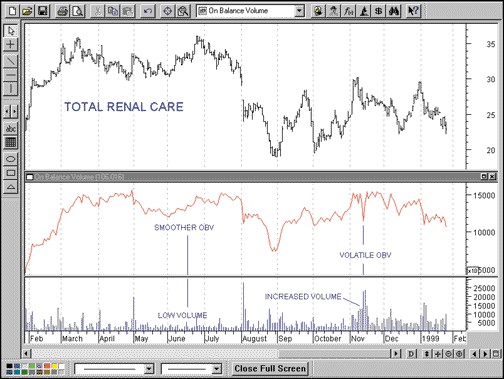INDICATORS
On-Balance Volume
by Stuart Evens
What do technicians look at in order to qualify the significance of a trend? One key element is volume, in that high volume in a trend indicates that large players may be involved. The theory goes that large traders are better informed, so the trend is likely to continue. How can you track volume? Does a volume-based indicator help the analyst and trader? Take a look.

OBV PHILOSPOHYFIGURE 1: TOTAL RENAL CARE. This common layout of price bars, OBV line, and volume bars for Total Renal Care shows the interrelationships between each of these data. Note the effect that increased volume has on the magnitude of change, and that net price change only determines the direction of the line.
OBV creator Joseph Granville first presented the concept of OBV in Granville's New Key To Stock Market Profits. In developing this tool, Granville started with the premise that market participants are divided into smart money entities and the general public. He assumed that the smart money was able to accumulate stock at lower prices compared with that of the public based on their having better information.
During a bull market, Granville theorized, smart money initially bids prices up and then only participates in the buying for the first-half to two-thirds of the move. At that point, smart money players are fully invested and are now holding for the last third of the move, planning to sell out at the top. He opined that this is just when most of the public is starting to notice the runup in prices and is buying the stock. This sets the stage for the smart money, who then dumps stock to the public.
When the public finally realizes what is happening and rushes to sell, the stock is already in a bear market and the price accelerating downward. Granville developed his technique of tracking the OBV line to detect the movement of smart money in the marketplace, and more important, whether the smart money is accumulating or distributing shares. Therefore, for the technical analyst using OBV to be successful, this phenomenon of smart money versus the general public must be in place. The smart money needs someone to sell to and someone to buy from. In both cases, that someone is the uninformed individual investor. Granville's goal in developing OBV was to provide a method to avoid trading like the uninformed investor.
A comparison can be made between OBV analysis and fundamental analysis. William Eng, in his Technical Analysis Of Stocks, Options, & Futures, discusses similarities between Granville's OBV and fundamental analysis. Granville's goal was to emulate large traders and investors (smart money), which might possess fundamental inside knowledge. Many times, the buying or selling of the informed investor can be contrary to the more obvious and immediately visible trend of the market and therefore can be viewed as a contrarian technical method, Eng states.
Obv can be thought of as a technical gauge of fundamental information that informed traders use to make their investment decisions. Once we determine, with the help of our indicator, what direction the smart money is trading, we can trade in the same direction and thereby benefit from the information without actually knowing what the information is.
Ultimately, what that fundamental information is, or who the smart money investors are, is inconsequential to the effective use of OBV. All that is required is that price is determined by the informed smart money, and there exists a technique that can identify stock movement resulting from transactions made by this group. Granville presented on-balance volume as a technique capable of doing just that.